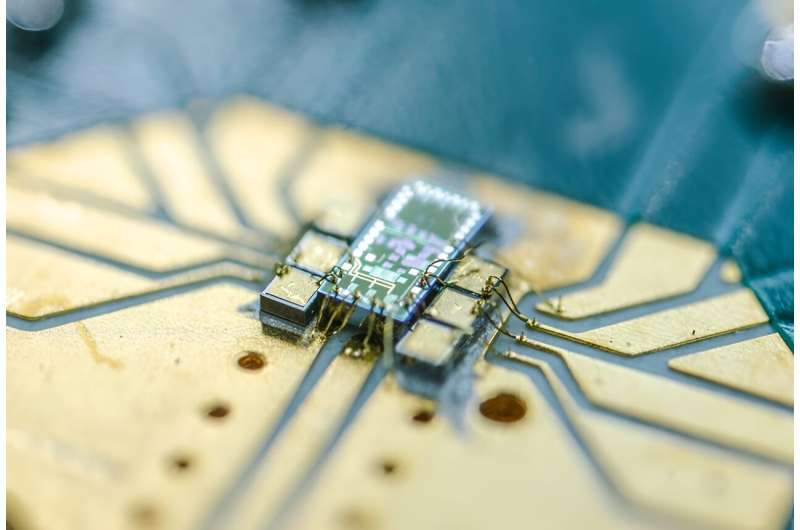The silicon ePIC quantum chip, mounted on a printed circuit board for testing and similar to a motherboard inside a personal computer. Credit: University of Bristol
Researchers at the University of Bristol have made an important breakthrough in scaling quantum technology by integrating the world's tiniest quantum light detector onto a silicon chip. The paper, "A Bi-CMOS electronic photonic integrated circuit quantum light detector," was published in Science Advances.
A critical moment in unlocking the information age was when scientists and engineers were first able to miniaturize transistors onto cheap micro-chips in the 1960s.
Now, for the first time, University of Bristol academics have demonstrated the integration of a quantum light detector—smaller than a human hair—onto a silicon chip, moving us one step closer to the age of quantum technologies using light.
Making high-performance electronics and photonics at scale is fundamental to realizing the next generation of advanced information technologies. Figuring out how to make quantum technologies in existing commercial facilities is an ongoing international effort being tackled by university research and companies around the world.
It could prove crucial for quantum computing to be able to make high-performance quantum hardware at scale due to the vast amount of components anticipated to build even a single machine.
In pursuit of this goal, researchers at the University of Bristol have demonstrated a type of quantum light detector that is implemented on a chip with a circuit that occupies 80 micrometers by 220 micrometers.
Critically, the small size means the quantum light detector can be fast, which is key to unlocking high-speed quantum communications and enabling high-speed operation of optical quantum computers.
The use of established and commercially accessible fabrication techniques helps the prospects for early incorporation into other technologies such as sensing and communications.
"These types of detectors are called homodyne detectors, and they pop up everywhere in applications across quantum optics," explains Professor Jonathan Matthews, who led the research and is Director of the Quantum Engineering Technology Labs.
"They operate at room temperature, and you can use them for quantum communications, in incredibly sensitive sensors—like state-of-the-art gravitational wave detectors—and there are designs of quantum computers that would use these detectors."
In 2021, the Bristol team showed how linking a photonics chip with a separate electronics chip can increase the speed of quantum light detectors—now with a single electronic-photonic integrated chip, the team has further increased speed by a factor of 10 while reducing footprint by a factor of 50.
While these detectors are fast and small, they are also sensitive.
"The key to measuring quantum light is sensitivity to quantum noise," explains author Dr. Giacomo Ferranti.
"Quantum mechanics is responsible for a minute, fundamental level of noise in all optical systems. The behavior of this noise reveals information about what kind of quantum light is traveling in the system, it can determine how sensitive an optical sensor can be, and it can be used to mathematically reconstruct quantum states. In our study, it was important to show that making the detector smaller and faster did not block its sensitivity for measuring quantum states."
The authors note that there is more exciting research to do in integrating other disruptive quantum technology hardware down to the chip scale. With the new detector, the efficiency needs to improve, and there is work to be done to trial the detector in lots of different applications.
Professor Matthews added, "We built the detector with a commercially accessible foundry in order to make its applications more accessible. While we are incredibly excited by the implications across a range of quantum technology, it is critical that we as a community continue to tackle the challenge of scalable fabrication of quantum technology.
"Without demonstrating truly scalable fabrication of quantum hardware, the impact and benefits of quantum technology will be delayed and limited."
More information: Joel Tasker et al, A Bi-CMOS electronic-photonic integrated circuit quantum light detector, Science Advances (2024). DOI: 10.1126/sciadv.adk6890. www.science.org/doi/10.1126/sciadv.adk6890
Journal information: Science Advances
Provided by University of Bristol























